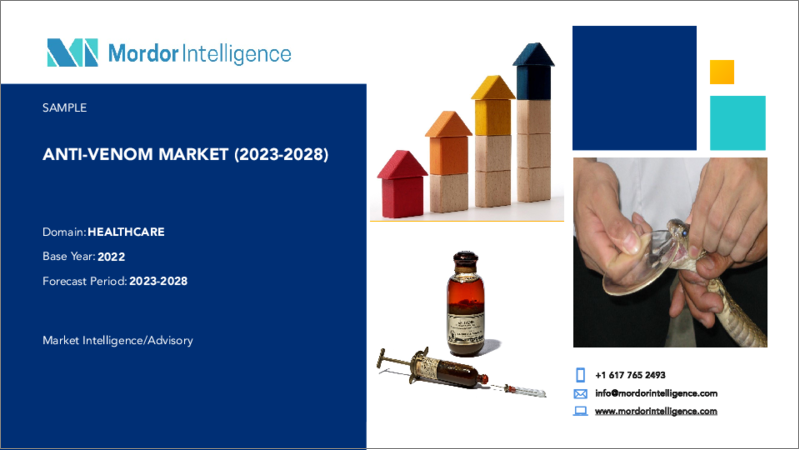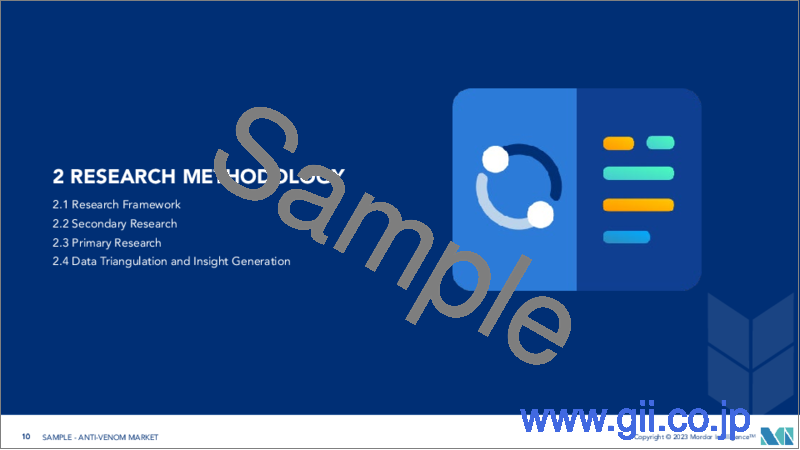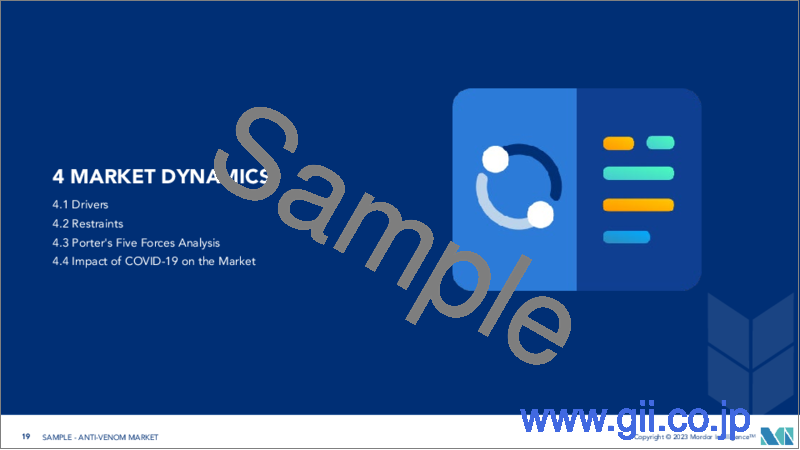|
|
市場調査レポート
商品コード
1189834
抗毒素市場- 成長、動向、予測(2023年~2028年)Anti-Venom Market - Growth, Trends, and Forecasts (2023 - 2028) |
||||||
|
● お客様のご希望に応じて、既存データの加工や未掲載情報(例:国別セグメント)の追加などの対応が可能です。 詳細はお問い合わせください。 |
|||||||
| 抗毒素市場- 成長、動向、予測(2023年~2028年) |
|
出版日: 2023年01月18日
発行: Mordor Intelligence
ページ情報: 英文 116 Pages
納期: 2~3営業日
|
- 全表示
- 概要
- 目次
抗毒素市場は、予測期間中に約8.54%のCAGRで推移すると予想されています。
COVID-19が流行した際、いくつかの地域で蛇に噛まれたことによる死亡者数がかなり増加しました。このため、抗毒薬のニーズが非常に高まりました。しかし、すでに脆弱な医療システムにおけるパンデミックによる優先順位の変化は、あらゆるレベルの蛇咬傷ケアに影響を及ぼしました。2021年10月にBritish Medical Journalに掲載された研究によると、2020年にCOVID-19のパンデミックが宣言された後、アジア、アフリカ、ラテンアメリカの最も貧しく、最も田舎のコミュニティで、推定270万件の蛇咬症(SBE)が10万人を超える死亡者と40万人の長期障害を引き起こしたそうです。こうした研究は、流行の中で治療格差が大きく浮き彫りになりました。一方、SARS-CoV-2ウイルスの新型が世界的に流行した後の段階では、市場は安定したペースで成長すると予想されます。例えば、Cold Spring Herber Laboratoryが2022年1月に発表した研究によると、ヘビ毒ホスホリパーゼA2は、in vitroでSARS-CoV-2に対して高い殺ウイルス活性を示し、スパイク糖タンパク質がACE2受容体と結合することで媒介する細胞融合を防ぐことが判明しているとのことです。したがって、分析によると、このような事例は、COVID-19患者の間で抗悪性腫瘍剤の需要を増大させ、その結果、予測期間にわたって市場の成長を推進する可能性があります。
調査された市場の成長は、主に市場で利用可能な抗毒素の意識の高まり、毒咬傷の例の急増、および技術の進歩などの要因に起因することができます。蛇咬傷は、多くの熱帯および亜熱帯の国々で最も無視されている公衆衛生問題の1つです。WHOによる2021年5月の更新によると、毎年約540万件の蛇咬傷が発生し、最大270万件のenvenomings(蛇咬傷による中毒)と約81,000~138,000人の死亡を引き起こしています。さらに、その3倍程度の切断などの後遺症につながることも多いです。2022年8月のレポート「インドにおける事故死・農場自殺」によると、2021年にインドで報告されたヘビ咬傷の件数は10,450件で、10,382人が死亡、64人が負傷しているとのことです。さらに、2021年の蛇咬傷による死亡者数は、マディヤ・プラデーシュ州が2,732人で1位、次いでオディシャ州(1,019人)、チャッティースガル州(909人)、ウッタルプラデーシュ州(844人)というデータが出ています。このように、蛇咬傷の発生率の増加は、抗毒素治療の需要を増加させ、市場の成長を押し上げると予想されます。
さらに、毒物による咬傷や刺傷の有病率は年々増加しています。抗毒薬の需要に対応するため、市場参加者は市場での存在感を強化するために多くのイニシアチブを選択しています。例えば、2021年9月には、パプアニューギニア(PNG)とオーストラリアが抗毒素を寄贈し、毒蛇や海洋生物に噛まれたり刺されたりした人々の命を救うためのパートナーシップが、2021年から2023年のさらに2年間延長されました。これにより、国を超えて抗毒薬の入手性が向上するため、市場成長の原動力となります。
しかし、抗毒薬の製造は困難であり、コストも高いです。抗毒素のコストは過去20年間で上昇し、ほとんどの人にとって治療が手の届かないものになっています。このことが、予測期間中の市場成長の妨げになると予想されます。
主な市場動向
予測期間中、多価抗毒素セグメントが市場で大きなシェアを占めると予想される
多価抗毒素は、さまざまな種/属の同種類の毒に対抗できる抗体で構成されています。多価蛇毒薬には、ブラウンスネーク毒薬、タイガースネーク毒薬、デスアダー毒薬、タイパン毒薬、ブラックスネーク毒薬などの活性成分が含まれています。多価蛇毒薬は、蛇の種類が不明で一価蛇毒薬が選択できない場合でも、蛇毒による被害者の命を救うことができます。このような利点があるため、多価抗毒素は最も好まれる抗毒素製剤です。
多価抗毒素は、毒蛇の種類が多く、すべての毒蛇に対する一価の抗毒素を製造することが困難な場合に有効です。このように多くの利点があるため、抗毒薬市場を扱う主な企業は、多価抗毒薬の開発に注力しています。
さらに、既存の治療法の有効性を証明する研究開発活動の高まりは、調査対象セグメントをさらに推進することが期待されています。例えば、2021年10月にToxin Baselに掲載された研究によると、インドの2つの多価抗毒素、VINSおよびBharatは、スリランカのコブラ(Naja naja)毒によって引き起こされるin vitro筋毒性の予防または逆転に肯定的な結果を示し、したがってコブラ咬傷を治療するための治療薬として積極的に使用することができるようになりました。
このように、多価の抗毒液の利点や研究開発活動の拡大などの要因により、予測期間中にこのセグメントの成長が加速することが予想されます。
北米が市場で重要なシェアを占め、予測期間中も同様と予想される
北米の抗毒薬市場は、蛇咬傷やその他の毒咬傷の発生率の高さ、毒咬傷に対する意識の高まり、技術的進歩の上昇などにより、予測期間中に大きなシェアを占めると予想されます。北米内の米国は、同地域の市場成長に大きく貢献すると予想されます。CDCによる2021年6月の記事の通り、米国では毎年、推定7,000~8,000人が毒蛇に咬まれ、そのうち約5人が亡くなっています。労働者はヘビに噛まれて死ぬよりも、長期的な怪我をする可能性の方がはるかに高いのです。したがって、同国におけるヘビ咬傷の高い有病率により、その治療薬に対する需要が増加し、市場の成長を後押しすることが期待されます。
さらに、主要な市場関係者による製品承認や戦略的イニシアティブも、同国における市場の成長を増大させると予想されます。例えば、2022年3月、Ophirex, Inc.は、米国FDAが蛇咬傷の治療薬としてvarespladib-methyl(「経口varespladib」)にFast Track指定を付与したと発表しました。オフィレックスは、現在、リードする治験薬候補である経口varespladibを、米国およびインドにおいて広域蛇咬傷解毒薬として臨床試験を実施しています。
さらに、2021年4月、レアディーズ・セラピューティクス社は、馬由来の抗毒素であるANAVIP(crotalidae immune F(ab')2(equine))について、北米マムシ咬傷の成人および小児患者の管理という新たな適応拡大承認を米国FDAより受けたと発表しました。
このように、ヘビ咬傷の高い有病率や市場関係者の戦略的な取り組みなど、上記の要因により、北米地域の市場は予測期間中に力強い成長を遂げると予想されます。
競合情勢
抗毒素市場は競争が激しく、複数の市場プレーヤーで構成されています。バイオテクノロジー施設が確立されているほとんどの新興諸国は、現地の科学的専門知識を有しており、現地で抗毒素の製造方法を確立するための好条件と雰囲気を作り出しています。ブラジル、コスタリカ、エジプト、フランス、インド、メキシコ、南アフリカ、タイなどの国には、大規模で定評のある駆除剤メーカーがあります。抗毒素市場で事業を展開している主な市場参加者には、BTG PLC、Pfizer Inc.、Merck KGaA(Sigma Aldrich)、Boehringer Ingelheim、CSL Limitedなどが挙げられます。
その他の特典
- エクセル形式の市場予測(ME)シート
- 3ヶ月間のアナリストサポート
目次
第1章 イントロダクション
- 調査の前提条件と市場の定義
- 調査対象範囲
第2章 調査手法
第3章 エグゼクティブサマリー
第4章 市場力学
- 市場概要
- 市場促進要因
- 抗悪性腫瘍剤に関する認知度の向上
- 技術的進歩
- 市場抑制要因
- 適切な免疫原の調製に伴う複雑さ
- 各国における抗毒素の規制能力の欠如
- ファイブフォース分析分析
- 新規参入業者の脅威
- 買い手/消費者の交渉力
- 供給企業の交渉力
- 代替品の脅威
- 競争企業間の敵対関係
第5章 市場セグメンテーション(金額ベース市場規模:単位:100万米ドル)
- 品種別
- ヘビ
- サソリ
- クモ
- その他の種
- 抗毒素の種類別
- 多価抗毒素
- 一価の抗毒素
- その他の毒物
- 地域別
- 北米
- 米国
- カナダ
- メキシコ
- 欧州
- ドイツ
- 英国
- フランス
- イタリア
- スペイン
- その他の欧州地域
- アジア太平洋地域
- 中国
- 日本
- インド
- オーストラリア
- 韓国
- その他アジア太平洋地域
- 中東・アフリカ地域
- GCC
- 南アフリカ
- その他中東地域
- 南米地域
- ブラジル
- アルゼンチン
- その他の南米地域
- 北米
第6章 競合情勢
- 企業プロファイル
- Bharat Serums and Vaccines Ltd
- Boehringer Ingelheim International GmbH
- Boston Scientific Corporation
- CSL Limited
- Flynn Pharma Ltd(Micropharm)
- Merck & Co. Inc.
- Merck KGaA(Sigma Aldrich)
- Pfizer Inc.
- Rare Disease Therapeutics Inc.
- South African Vaccine Producers(Pty)Ltd
第7章 市場機会と今後の動向
The anti-venom market is expected to register a CAGR of nearly 8.54% during the forecast period.
During the COVID-19 epidemic, there was a considerable increase in the number of deaths reported from snake bites in a few regions. This caused a significant need for anti-venoms. However, shifting priorities due to the pandemic in already vulnerable health systems impacted snakebite care on all levels. According to the study published in the British Medical Journal in October 2021, after the COVID-19 pandemic was proclaimed in 2020, an estimated 2.7 million cases of snakebite envenoming (SBE) caused over 100,000 fatalities and 400,000 long-term impairments across Asia, Africa, and Latin America's poorest and most rural communities. Such studies greatly highlighted the treatment gap amid the outbreak. On the other hand, the market is expected to grow at a stable pace in the post-pandemic phase with the emerging strains of the SARS-CoV-2 virus worldwide. For instance, according to the study published by Cold Spring Herber Laboratory in January 2022, snake venom phospholipases A2 were found to have high virucidal activity against SARS-CoV-2 in vitro and to prevent cell fusion mediated by spike glycoprotein binding with the ACE2 receptor. Thus, as per the analysis, such instances are likely to augment the demand for anti-venoms among COVID-19 patients, in turn propelling the market's growth over the forecast period.
The studied market growth can largely be attributed to factors such as the increasing awareness of anti-venoms available in the market, the surge in cases of venomous bites, and technological advancements. Snakebite is one of the most neglected public health issues in many tropical and subtropical countries. According to the May 2021 update by the WHO, approximately 5.4 million snake bites occur each year, resulting in up to 2.7 million envenomings (poisonings from snake bites) and about 81,000 to 138,000 deaths. Moreover, it often leads to around three times as many amputations and other permanent disabilities. According to the August 2022 report "Accidental Deaths & Farm Suicides in India," 10,450 snakebite cases were reported in India in 2021, with 10,382 individuals dying and 64 injured. Furthermore, the data indicated that in 2021, Madhya Pradesh scored first in terms of snake bite deaths (2,732), followed by Odisha (1,019), Chhattisgarh (909), and Uttar Pradesh (844). Thus, the growing incidence of snake bites is expected to increase demand for anti-venom treatment, thereby boosting the growth of the market.
Furthermore, the prevalence of venomous bites and stings has increased over the years. To cater to the demand for anti-venom drugs, market players are opting for many initiatives to strengthen their market presence. For instance, in September 2021, a partnership between Papua New Guinea (PNG) and Australia to donate anti-venom and help save the lives of people bitten or stung by venomous snakes and marine creatures was extended for a further two years, 2021-2023. This will increase the accessibility of anti-venomous drugs across countries, thus driving the market growth.
However, anti-venom production is difficult and expensive. The cost of anti-venom has increased over the last two decades, making treatment unaffordable for most people. This is expected to hinder market growth over the forecast period.
Key Market Trends
The Polyvalent Anti-venoms Segment is Expected to Hold Significant Share in the Market Over the Forecast Period
Polyvalent anti-venoms consist of antibodies that are capable of counteracting several homologous venoms from various species/genera. Polyvalent snake antivenom contains the active ingredients brown snake antivenom, tiger snake antivenom, death adder antivenom, taipan antivenom, and black snake antivenom. Polyvalent antivenoms can save the lives of victims of snake envenomation, even when the culprit snake is unknown and a monovalent antivenom cannot be chosen. Due to the obvious advantages that they have, polyvalent anti-venoms are the most preferred anti-venom drug.
Polyvalent anti-venoms are beneficial in regions where there is a large presence of venomous species and when it is difficult to produce monovalent anti-venoms against all of them. Owing to the numerous advantages, the key players dealing in the anti-venom market are focusing on developing polyvalent anti-venoms.
Furthermore, rising research and development activities proving the efficacies of existing treatments are further expected to drive the studied segment. For instance, according to the study published in Toxin Basel in October 2021, two Indian polyvalent anti-venoms, VINS and Bharat, showed positive results in preventing or reversing in vitro myotoxicity induced by common cobra (Naja naja) venom from Sri Lanka and hence can be proactively used as a therapeutic in treating cobra bites.
As a result of the aforementioned factors, such as the advantages of polyvalent anti-venom and expanding research and development activities, the segment's growth is expected to accelerate over the forecast period.
North America is Expected to Hold a Significant Share in the Market and Expected to do Same in the Forecast Period
The North American anti-venom market is expected to hold a significant share during the forecast period, owing to the high incidence of snake bites and other venomous bites in the region, the rise in awareness of venomous bites, and rising technological advancements. United States within North America is expected to contribute significantly to the market growth in the region. As per the June 2021 article by the CDC, each year, an estimated 7,000-8,000 people are bitten by venomous snakes in United States, and about five of those people die. Workers are far more likely to suffer long-term injuries from snake bites than to die from them. Thus, due to the high prevalence of snake bites in the country, the demand for its therapeutics is expected to increase, thereby boosting the market's growth.
Moreover, product approvals and strategic initiatives by key market players are also expected to augment market growth in the country. For instance, in March 2022, Ophirex, Inc., announced that the US FDA had granted Fast Track designation to varespladib-methyl ("oral varespladib") for the treatment of snakebite. Ophirex is currently conducting a clinical trial of oral varespladib, its lead investigational drug candidate, as a broad-spectrum snakebite antidote in United States and India.
Furthermore, in April 2021, Rare Disease Therapeutics, Inc. announced that the US FDA approved a new expanded indication for ANAVIP (crotalidae immune F(ab')2 (equine)), an equine-derived antivenin, for the management of adult and pediatric patients with North American pit viper envenomation.
Thus, due to the above-mentioned factors, such as the high prevalence of snake bites and strategic initiatives by market players, the market in the North American region is expected to witness strong growth over the forecast period.
Competitive Landscape
The anti-venom market is competitive, and consists of several market players. Most developing countries with established biotechnological facilities have local scientific expertise, which creates favorable conditions and the atmosphere to establish local anti-venom manufacturing practices. Countries such as Brazil, Costa Rica, Egypt, France, India, Mexico, South Africa, and Thailand have large, well-established anti-venom manufacturers. The major market players operating in the anti-venom market include BTG PLC, Pfizer Inc., Merck KGaA (Sigma Aldrich), Boehringer Ingelheim, and CSL Limited, among others.
Additional Benefits:
- The market estimate (ME) sheet in Excel format
- 3 months of analyst support
TABLE OF CONTENTS
1 INTRODUCTION
- 1.1 Study Assumptions and Market Definition
- 1.2 Scope of the Study
2 RESEARCH METHODOLOGY
3 EXECUTIVE SUMMARY
4 MARKET DYNAMICS
- 4.1 Market Overview
- 4.2 Market Drivers
- 4.2.1 Increasing Awareness on Anti-venoms Available
- 4.2.2 Technological Advancements
- 4.3 Market Restraints
- 4.3.1 Complexities Involved in the Preparation of the Correct Immunogens
- 4.3.2 Lack of Regulatory Capacity for the Control of Anti-venoms in Countries
- 4.4 Porter's Five Forces Analysis
- 4.4.1 Threat of New Entrants
- 4.4.2 Bargaining Power of Buyers/Consumers
- 4.4.3 Bargaining Power of Suppliers
- 4.4.4 Threat of Substitute Products
- 4.4.5 Intensity of Competitive Rivalry
5 MARKET SEGMENTATION (Market Size by Value - in USD Million)
- 5.1 By Species
- 5.1.1 Snake
- 5.1.2 Scorpion
- 5.1.3 Spiders
- 5.1.4 Other Species
- 5.2 By Anti-venom Type
- 5.2.1 Polyvalent Anti-venoms
- 5.2.2 Monovalent Anti-venom
- 5.2.3 Other Anti-venom Types
- 5.3 Geography
- 5.3.1 North America
- 5.3.1.1 United States
- 5.3.1.2 Canada
- 5.3.1.3 Mexico
- 5.3.2 Europe
- 5.3.2.1 Germany
- 5.3.2.2 United Kingdom
- 5.3.2.3 France
- 5.3.2.4 Italy
- 5.3.2.5 Spain
- 5.3.2.6 Rest of Europe
- 5.3.3 Asia-Pacific
- 5.3.3.1 China
- 5.3.3.2 Japan
- 5.3.3.3 India
- 5.3.3.4 Australia
- 5.3.3.5 South Korea
- 5.3.3.6 Rest of Asia-Pacific
- 5.3.4 Middle East and Africa
- 5.3.4.1 GCC
- 5.3.4.2 South Africa
- 5.3.4.3 Rest of Middle East and Africa
- 5.3.5 South America
- 5.3.5.1 Brazil
- 5.3.5.2 Argentina
- 5.3.5.3 Rest of South America
- 5.3.1 North America
6 COMPETITIVE LANDSCAPE
- 6.1 Company Profiles
- 6.1.1 Bharat Serums and Vaccines Ltd
- 6.1.2 Boehringer Ingelheim International GmbH
- 6.1.3 Boston Scientific Corporation
- 6.1.4 CSL Limited
- 6.1.5 Flynn Pharma Ltd (Micropharm)
- 6.1.6 Merck & Co. Inc.
- 6.1.7 Merck KGaA (Sigma Aldrich)
- 6.1.8 Pfizer Inc.
- 6.1.9 Rare Disease Therapeutics Inc.
- 6.1.10 South African Vaccine Producers (Pty) Ltd




